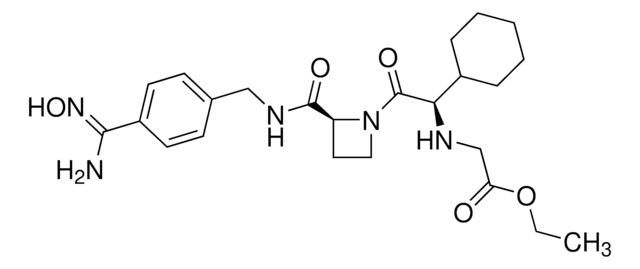Z101
Zimelidine dihydrochloride
solid
Sinonimo/i:
(Z)-3-(4-Bromophenyl)-N,N-dimethyl-3-(3-pyridinyl)-2-propen-1-amine dihydrochloride
About This Item
Prodotti consigliati
Stato
solid
Colore
white
Solubilità
0.1 M HCl: 45 mg/mL
H2O: 66 mg/mL
Ideatore
AstraZeneca
Stringa SMILE
Cl[H].Cl[H].[H]\C(CN(C)C)=C(/c1ccc(Br)cc1)c2cccnc2
InChI
1S/C16H17BrN2.2ClH/c1-19(2)11-9-16(14-4-3-10-18-12-14)13-5-7-15(17)8-6-13;;/h3-10,12H,11H2,1-2H3;2*1H/b16-9-;;
CXGURXWCQYHDIR-ULPVBNQHSA-N
Informazioni sul gene
human ... HTR1A(3350) , HTR1B(3351) , HTR1D(3352) , HTR1E(3354) , HTR1F(3355) , HTR2A(3356) , HTR2B(3357) , HTR2C(3358) , HTR3A(3359) , HTR3B(9177) , HTR3C(170572) , HTR3D(200909) , HTR3E(285242) , HTR4(3360) , HTR5A(3361) , HTR5B(645694) , HTR6(3362) , HTR7(3363)
Applicazioni
Azioni biochim/fisiol
Caratteristiche e vantaggi
Note legali
Avvertenze
Warning
Indicazioni di pericolo
Consigli di prudenza
Classi di pericolo
Acute Tox. 4 Oral
Codice della classe di stoccaggio
11 - Combustible Solids
Classe di pericolosità dell'acqua (WGK)
WGK 3
Punto d’infiammabilità (°F)
Not applicable
Punto d’infiammabilità (°C)
Not applicable
Dispositivi di protezione individuale
dust mask type N95 (US), Eyeshields, Gloves
Scegli una delle versioni più recenti:
Possiedi già questo prodotto?
I documenti relativi ai prodotti acquistati recentemente sono disponibili nell’Archivio dei documenti.
Il team dei nostri ricercatori vanta grande esperienza in tutte le aree della ricerca quali Life Science, scienza dei materiali, sintesi chimica, cromatografia, discipline analitiche, ecc..
Contatta l'Assistenza Tecnica.








